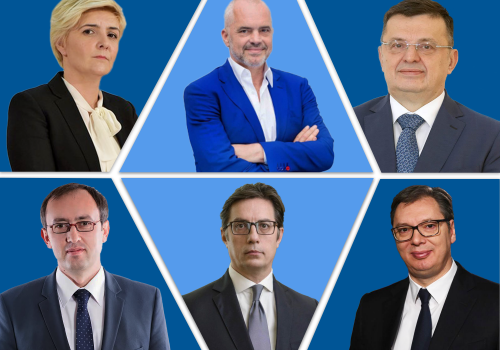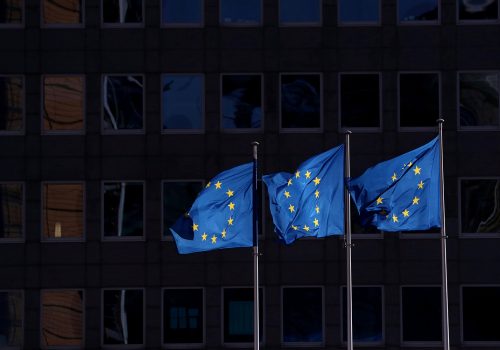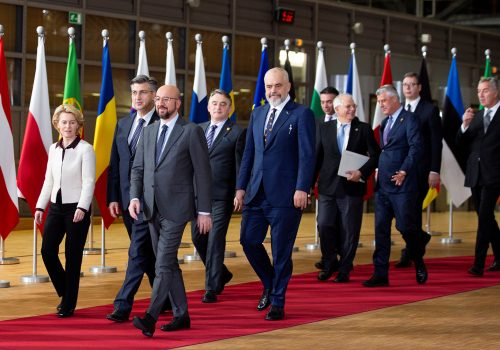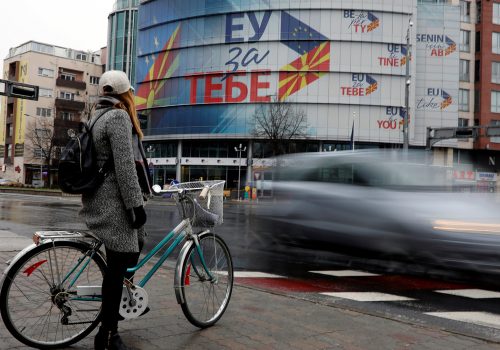In Sofia on November 10, the Western Balkans Six—Albania, Bosnia and Herzegovina, Kosovo, Montenegro, North Macedonia, and Serbia—the European Union, and ten European countries belonging to the Berlin Process will set an agenda for the next four years. This report discusses what is likely to emerge and what might need to be done later.
On July 30, the Atlantic Council hosted a meeting of government leaders from the Western Balkans Six at which leaders agreed to practical steps toward economic integration within the region and between the region and the European Union. This assessment was promised in the conclusion of that meeting.
Summary
The Sofia meeting comes toward the end of a horrible year, but also as substantial new international investment funds are committed, European Union (EU) accession talks with Albania and North Macedonia are being prepared, and there is a glimmer of hope for less transatlantic competition on the Balkans.
Against this backdrop, the Sofia summit is likely to make regional economic integration the organizing principle for international engagement in the region. This report makes two points. First, visible results matter. For example, trucks should not dawdle at Western Balkans Six (WB6) borders, and investments should be seen to produce jobs soon. Sofia needs clear goals and a way of tracking success.
Second, the Western Balkans 6 (WB6) have agency. Their advocacy for a regional focus over the past eighteen months already has changed the international agenda. The leaders of the WB6 should continue to press for a focus on results, especially with regard to investments. The international architecture to coordinate investments seems unlikely to meet the current need for regional, near-term impact, especially in the private sector. The WB6 can address this gap through their own actions, and the announcement on October 30 that several states will create a permanent working group on regional economic integration is welcome. The international community should look at revising this part of its strategy.
The greatest danger is that the outcomes of the Sofia meeting will reflect what the region’s international partners are comfortable doing, rather than what the people of the Western Balkans need done. The report makes three recommendations:
- First, substantial investments must be focused on quick impact projects, especially on energy efficiency (a large source of jobs) and renewables. The WB6 can lead in this effort: a group of senior officials can identify ten such projects over the next several in time for investment decisions to be made as the end of the pandemic likely comes into view.
- Second, keep goals simple and constant—and monitored.
- Third, the WB6 should build on its advocacy success: take action before the internationals act.
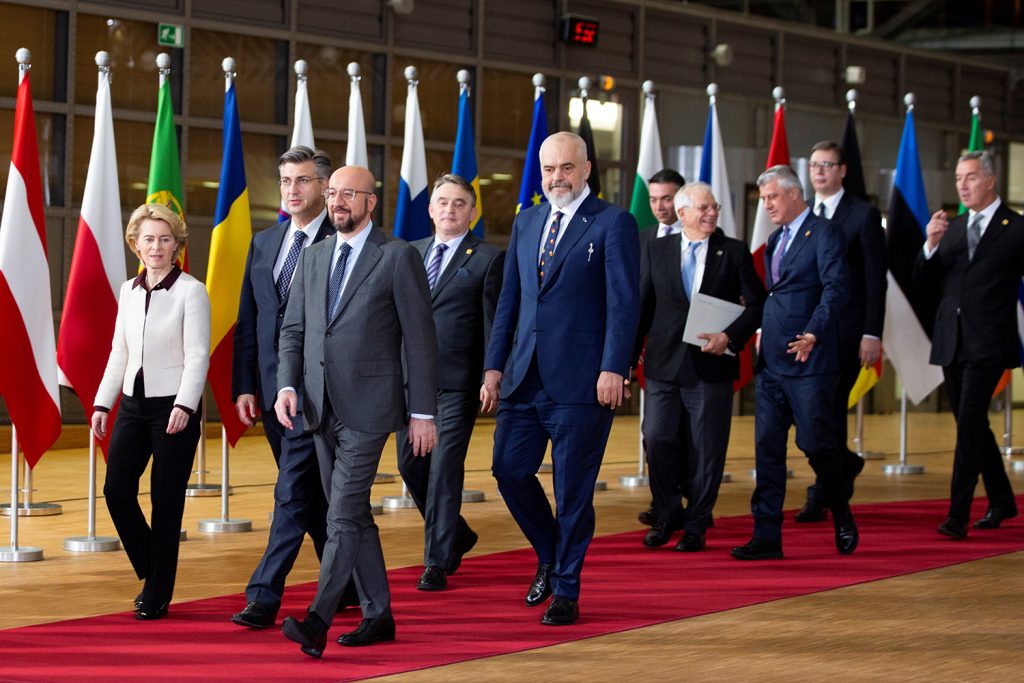
The greatest danger is that the outcomes of the Sofia meeting will reflect what the region’s international partners are comfortable doing, rather than what the people of the Western Balkans need done.
Background: Why does the Sofia Summit matter?
What is the Sofia Summit?
The Sofia Summit is a meeting of the Berlin Process, established in 2014 to provide an informal umbrella for both cooperation within the region and economic relationships with EU member states, goals reflected in a diversity of initiatives with overlapping memberships and objectives. It is intertwined with EU enlargement, both politically (the German Presidency of the EU will support the result) and in practice (the European Commission provides substantial support to key elements of all regional initiatives). The Sofia Summit should also provide an opportunity to address regional concerns including tensions between Bulgaria and North Macedonia, which are co-hosts of the event. These bilateral tensions may affect the Summit in ways beyond the scope of this paper.
Why does the Berlin Process matter?
The Berlin Process brought together the WB6, the European Commission, sixteen EU member states, and the secretariats of multiple organizations such as the Central European Free Trade Agreement (CEFTA), the Energy Community Secretariat, and the Transportation Secretariat.
The Berlin Process created the Regional Coordination Commission, headquartered in Sarajevo, as a way of providing transparency about these initiatives, without the ability to control them. In 2017, in Trieste a working program aimed at removing barriers to trade.
The agenda agreed in Sofia will run through 2024, that is, through much of the current European Commission, of the next US presidential term, and into the initial Balkan policies of the next, post-Angela Merkel German Government. With France heading into President Emmanuel Macron’s re-election campaign, and a post-Brexit Britain looking for its global role, the decisions at Sofia will be a baseline for international approaches to the region.
Small space, big problems
Like the rest of Europe, the Western Balkans is suffering through a terrible 2020, with the pandemic causing gross domestic product (GDP) to shrink by up to 15 percent. The political cost of this crisis will rise in the next years. Over the longer term, the region’s demographic crisis continues, with 15-20 percent of the population expected to migrate for opportunity elsewhere. Tensions within and among the WB6 too often impede progress on a regional economic agenda.
State capture by elites remains an obstacle to reform, one that the EU accession process has not shown itself able to address. Perhaps worse, if the region’s most prepared candidates to join the EU succeed, they may leave behind a region lacking both strong champions in the EU and economies able to compete. The regional common market can be developed and in place before any of the WB6 is accepted into the EU. Done properly, the common market can prepare every state better. It is crucial, as the report will show, that the common market not be disrupted by the accession of any one state.
What to expect from Sofia: Regional economic integration
Judging by preparatory meetings for Sofia, the Summit will agree on the goal of a regional common market, tied closely to the region’s integration into European supply chains.
At a rhetorical level, this will not look entirely new. The Zagreb EU Summit in May referred to the importance of regional economic integration as part of the region’s path forward, and the Berlin Process itself was created to encourage regional cooperation. Every EU strategy for the region calls for more cooperation, and at times integration. But a secret of progress is to persuade decisionmakers that what is being agreed has been agreed before.
The test of success in Sofia is whether all international initiatives re-organize around the establishment of a regional common market. Sofia will produce a blizzard of specific goals, many of them having to do with completing the Berlin Process agenda for the last four years. What will matter is whether the strategy reflects the importance of a market—free movement of goods, services, people, and capital—rather than merely specific and limited goals.
Several items that may be in the Declaration would serve as benchmarks for a forward-looking, ambitious, and realistic agenda for the next several years:
- Green Lanes. At the start of the pandemic, the European Commission won agreement to facilitate the movement of food and health equipment across borders, including at major border crossings in the Western Balkans. These Green Lanes should be made permanent; expanded to all goods and services; and the expansion should include major border crossings between the WB6 and EU neighbors, as did the temporary measure in March. The crossings between Greece and Albania would benefit from special attention. Their smooth functioning and integration into the flow of goods would expand a western route into the region and, for Greece, into the EU.
- Digital Common Market, including regional 5G. In July, the WB6 leaders called for the exploration of a regional 5G network relying on European and American suppliers. The EU’s investment plan looks to the expansion of broadband throughout the region, an important goal but less ambitious and dependent on incumbents relying on Chinese technology. The leading investors should consider whether concerns over the reliability of suppliers should lead them to review those investments. The Sofia Declaration should clarify the region’s interest in 5G investments as specified by the leaders in July.
- Carbon free future. The region, especially Bosnia and Herzegovina, Kosovo, and Serbia, is among Europe’s most carbon intensive, relying on aging, inefficient coal plants. If the EU begins to charge for coal consumption, the economies of those three states would face a substantial tax. The EU’s Economic and Investment Plan (EIP) calls for a trebling of energy efficiency and for some large hydro projects but does not address the possibility of replacing these coal plants. The EIP also emphasizes natural gas transition pipelines as transitional projects, but the carbon intensity of natural gas may make them less valuable quickly; applying lessons from the UK’s transition from coal, where natural gas played a minimal role, could be valuable. The Sofia Declaration should be ambitious on carbon reductions and allow for the rapid transition of this marketplace, where prices of renewables are in some instances half that of coal.
- Implementation. Summits on the Western Balkans produce many commitments, often on the same subjects as previous convenings. Sofia should put in place a mechanism to track implementation, publicly and continuously. Annual reports are not enough. Leaders at the meeting are likely to decide that there should be a public scorecard, kept by the Regional Cooperation Council (RCC). This will be a good first step.
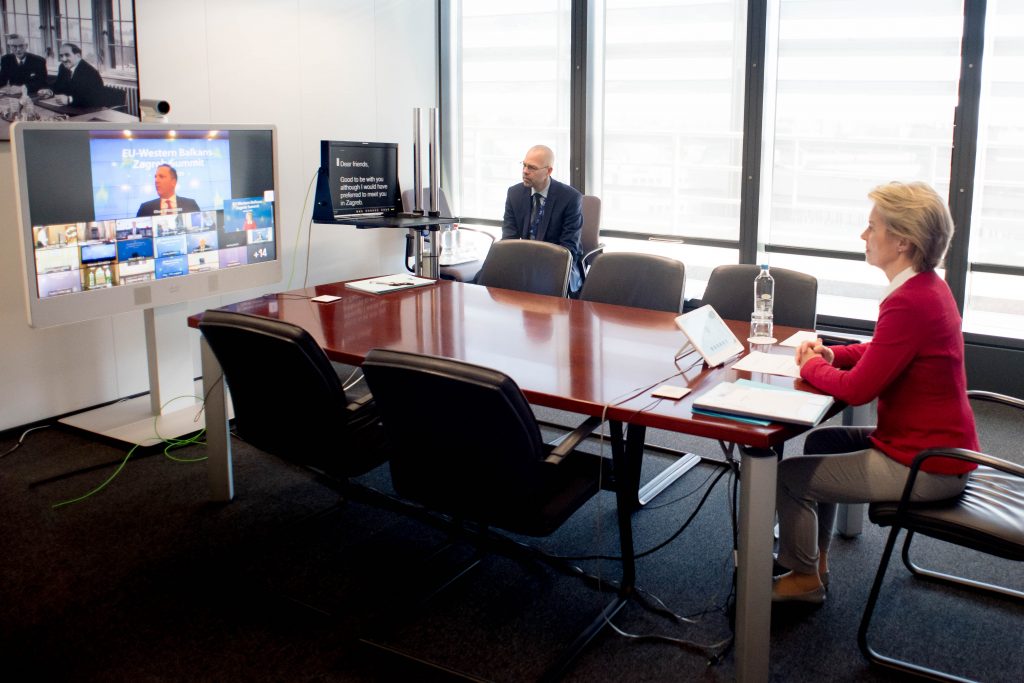
The test of success in Sofia is whether all international initiatives re-organize around the establishment of a regional common market.
Why does regional economic integration matter?
It may seem counter-intuitive that the WB6 could or should pursue economic integration, when all six focus on their bilateral processes with the EU; five of them are a generation or less from the dissolution of Yugoslavia; and the sixth—Albania—spent most of the post-World War Two period in isolation.
But two facts as real as gravity argue for regional economic integration. First, six small economies are worth much less than one region of 18 million people. Outsourcing to the region now costs a company in the EU single market at least twice the time and money of outsourcing to one of the ten states that joined the EU in 2004. For several of the WB6, like Kosovo, the costs are much higher, up to thirteen times the cost in time and money.
These costs flow from fragmentation. The World Bank famously estimated in 2016 that trucks spend 26 million hours a year—80 percent of their time—waiting to cross borders between the WB6. Anecdotes from developers and business owners suggest that shortages of workers, especially in regulated professions like engineering, impede economic developments. If those bottlenecks are removed, every state, including the region’s front-runners to join the EU, can prepare better to thrive once they acceded to the EU. And it is important that the accession of any one country not disrupt the common market by breaking trading patterns. The EU’s accession plans need to find ways to lift the entire region, not cherry-pick ones that succeed.
Second, current trading patterns will not lead to prosperity. Trade among the six shows that most is in primary goods or simple processes. Serbia, and to a lesser extent North Macedonia, are attracting higher-end economic activity, but their progress may be unsustainable without access to labor, capital, and goods from the other four, especially when a transition from subsidized coal-fired energy is needed. The path to prosperity runs up the value chain, something that is done most easily by joining supply chains.
In short, for much of the WB6, trade patterns today look like those of the Roman Empire. Prosperity requires attention to EU supply chains, and only regional economic integration can provide the depth of expertise and capacity needed to compete. For these reasons, the International Monetary Fund (IMF) and the European Bank for Reconstruction and Development (EBRD) have separately estimated that regional economic integration could boost GDP in each country by 10 percent above pre-pandemic levels.
What should come after Sofia?
Based on the EU’s Economic and Investment Plan and discussions thus far, three things are very likely to be needed:
First, investments should be focused on quick impact projects, especially on energy efficiency (a large source of jobs) and renewables. This will require that international investors reorganize. In discussions thus far, even as political goals are adjusting, investments are decided in bodies established to do conventional things. The EU’s Economic and Investment Plan, for example, lists ten flagship areas, nearly of all which are traditional, public infrastructure projects long discussed. These are important projects, but the kinds of investment bodies needed to carry out those projects are not ones likely to find nimble, private sector projects that promote innovation and have immediate impact. As just one example, the Western Balkans Investment Framework has no clear mandate to incorporate new commitments from the US Development Finance Corporation (DFC). An effort to engage the private sector more often, probably through road shows involving the Chambers of Commerce, has been called for repeatedly over the years. It will not produce better results without a clear focus and an international investor base prepared to engage on a quick-hit investment framework.
In the Atlantic Council meeting in July 2020, the WB6’s leaders called for projects with visible, immediate impact. This would mean mobilizing the private sector. The EU calls for a trebling in energy efficiency over the next years, but its only vehicle is an expansion of one EU-wide program. Something bolder and more clearly focused on the region is needed. A concerted, regional focus on providing the kinds of financing needed could be useful; in a region awash with liquidity, a loan guarantee program could open up energy efficiency quickly. The payoff in terms of construction jobs and supply chain expansion would be quick and visible.
The WB6 can lead in this effort. On October 30, political leaders of Albania, North Macedonia, and Serbia announced that they would form a permanent working group of officials to push forward regional economic integration. Its first task should be to identify ten or so projects ready for investment soon, with each project having regional importance, benefits for employment, and significance for energy efficiency or renewables, two areas where the region would benefit quickly.
It will take several months to identify these investments, but the pandemic will slow investor responses for that period anyway, so the preparation time will be well spent. Global investors, who do not now consider the region’s fragmented markets, may look seriously at a growing market of 18 million people with rights to trade into the EU, especially rights to trade in clean energy. The next several months will give the region time to persuade those investors to look again. It will also allow for the region to address investor concerns about the rule of law and cronyism; clear conditionality and dispute resolution procedures agreed in advance will make it easier for global investors to consider the region.
Second, keep goals simple and constant—and monitored. The array of regional initiatives can make it difficult to pick priorities or to tell whether anyone is in charge. Instead, all valuable goals are said to be pursued by all actors at all times, a situation that makes it hard to track and measure what is happening. The Sofia declaration cannot clear out the thicket of actors, but it can create priorities:
- set simple goals (waiting time for trucks, e.g., or speed to have degrees recognized; number of third country nationals traveling across the region);
- a public scorecard to track progress; and
- a single entity to govern the scorecard. Ideally this would be the RCC.
Priorities will flow toward what people see.
Third, the WB6 should build on its advocacy success: take action before the internationals act. It may prove too difficult for international structures to reorganize themselves. Each has its own mandate, sometimes treaty-based, and investment decisions tend to be market-driven. By bringing together international investing institutions and private sector investors, however, the region can foster an investment discussion focused on their needs soon. This should be an informal, rolling conversation rather than an annual event only (which the EBRD hosts already).
Can any of this work?
The short answer is that it has worked. Each region that has grown in prosperity has done so by getting to scale and mirroring the product baskets of wealthier trading partners.
And the WB6 already have shown that they can re-shape international approaches. It is through their concerted advocacy that the regional common market has become the organizing principle of the region. From 2018, leaders in Albania, North Macedonia, and Serbia had urged the establishment of a regional free trade zone built around the free movement of goods, services, people, and capital. In the fall of 2019, meetings in Novi Sad, Ohrid, and Tirana produced a series of agreements to achieve practical, visible goals, such as reducing waiting time for trucks at borders; visa-free travel for visitors; and simplified movement of professional service providers.
Significantly, these meetings did not aim to develop a regional initiative in parallel to existing institutions. Instead they set a template of advocacy by the WB6 to unlock initiatives that were stuck in existing venues. The Central European Free Trade Agreement (CEFTA), for instance, is problematic in Kosovo, due to its representation in CEFTA through UN institutions.
The Sofia meeting offers an opportunity to overcome the limitations of specific regional initiatives in pursuit of an efficient, functioning common market. Three significant developments give it this potential. With EU membership talks with Albania and North Macedonia expected to begin soon, four of the WB6 now have accession processes to mind. This provides guardrails for any regional economic initiative, as none of the larger economies will risk their EU prospects.
Second, and more recently, the EU and United States have made substantial new money available for public and private sector investment. In October 2020 the EU announced an initial 9 billion euro for investment in the region as part of its Economic and Investment Plan, with an additional goal of unlocking 20 billion euro through the Western Balkans Guarantee Facility.
Substantial additional funds will be available through the European Bank for Reconstruction and Development (EBRD), World Bank, and European Investment Bank (EIB), especially for projects related to the energy transition and public infrastructure. Collectively these institutions have available several billion euro for the region annually, although disbursement rates are comparatively low. The DFC a fortified successor to the Overseas Private Investment Corporation, has opened an office in Belgrade and has indicated its interest in pursuing regional projects, starting with participation in some bilateral Pristina-Belgrade projects.
Third, the transatlantic environment now supports regional economic cooperation. Both Washington and European capitals endorse regional economic cooperation, with the Pristina-Belgrade arrangement announced in Washington explicitly endorsing the efforts by the WB6 to build a regional common market. The specific items agreed in Washington between Pristina and Belgrade capture some bilateral elements of longer-standing regional commitments. More importantly, the occasionally energetic, but distracting, US effort to bring together Belgrade and Pristina should now be more easily coordinated with broader efforts aiming at regional economic integration.
James O’Brien is a Senior Advisor with the Future Europe Initiative and Vice Chair of Albright Stonebridge Group (ASG), where he heads the firm’s Europe practice.
Related reading
Image: European Council President Charles Michel and European Commission President Ursula von der Leyen walk with leaders of the Western Balkans; Croatian Prime Minister Andrej Plenkovic, Chairman of Bosnia and Herzogovina Zeljko Komsic, Albanian Prime Minister Edi Rama, European Union's foreign policy chief Josep Borrell, North Macedonia's Foreign Minister Nikola Dimitrov, Kosovo President Hashim Thaci, Serbian President Aleksandar Vucicj and Montenegro's President Milo Dukanovic, prior to a group photo at an EU-Western Balkans meeting at the Europa building in Brussels, Belgium February 16, 2020. Virginia Mayo /Pool via REUTERS
